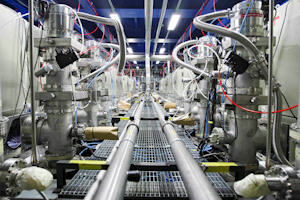May 6 2015
Scientists at Fermilab, just outside Chicago, want to fire a beam of particles through 1,300km (800 miles) of rock some 30km below the surface to a detector built in a former mine in South Dakota.
 neutrino detector
neutrino detector
The distance will enable scientists to study how neutrinos change as they travel through the Earth at close to the speed of light. It is a similar sized project to the Large Hadron Collider in CERN, Switzerland, which found the Higgs particle in 2012. The international Deep Underground Neutrino Experiment (DUNE) was newly formed by merging two major projects from Europe and the US.
Once finished the $1bn facility will host one of the biggest physics experiments ever attempted and technology designed at The University of Manchester is expected to play a key role. The UK’s Science and Technology Facilities Council (STFC) has recently awarded a major grant to the University of Manchester and other UK Universities to develop this technology.
Neutrinos are some of the most abundant and yet also most mysterious particles in the universe. They have tiny masses, but no one is sure why—or where those masses come from. They interact so rarely that they can pass through the entire Earth as if it weren’t there.
About 700 scientists from 23 countries are coming together to study neutrinos, rarely interacting particles that constantly bombard us from Space. They come in three types and oscillate, or change from type to type, as they travel long distances. Neutrinos play an important role in the evolution of the Universe and could hold important clues about how the Universe began and why matter greatly outnumbers antimatter, allowing us to exist.
Professor Stefan Soldner-Rembold from the School of Physics at The University of Manchester is one of the leading UK scientists on the DUNE project. He said: “This is a very exciting project to be part of and we have been involved from the start. The ultimate goal is to find differences between the behaviour of neutrinos and anti-neutrinos. It is so tricky to do because neutrinos can easily pass through a body such as the Earth without stopping. We therefore need huge detectors to trap them.
The scientists also hope to observe the neutrino burst from a supernova. About one such supernova is expected to occcur in our galaxy every 30 years. The detectors will be filled with 40,000 tons of liquid argon. Neutrino collisions create electrons and flashes of light in the liquid argon, which leave observable traces of the neutrinos.
Professor Soldner-Rembold said: “Together with other UK scientist we will build several components of the detector that will be crucial to the success of the project.
“Liquid argon detectors are an extremely exciting technology to make precision measurements with neutrinos. It’s the technology we’ll be using for the next 20 to 30 years of neutrino research.”
It is planned to have the facility operational by the early 2020’s.